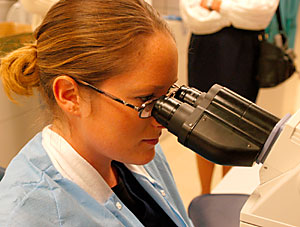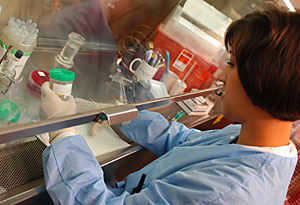 |
|
JACOB KONST/Arizona Daily Wildcat
|
Medical technology senior Erica Adamow examines cultures through a microscope at University Medical Center yesterday. The Medical Technology program works hard to find cures for serious medical conditions through the interpretation of patient data.
|
|
|
By Jeff Sklar
Arizona Daily Wildcat
Friday, February 20, 2004
Print this
Through a back door at UMC sits a drugstore-sized laboratory cluttered with computers, microscopes and centrifuges. Technologists hunched over the equipment examine blood samples and interpret computer printouts. Their task: making sure patients are diagnosed and treated properly.
If you're being treated at the hospital, you won't see the lab or these technologists. But if you've had blood drawn, a urine sample taken or other tests run, they may figure out what's wrong with you.
About 140 technologists work in the lab, many of them alumni of the UA's Medical Technology program. As of last year, somewhere between 30 percent and 60 percent of Tucson's medical technologists had graduated from the UA.
But top UA administrators put the program on the chopping block last year, saying it doesn't fit with the university's research mission and isn't attracting enough students.
"Interestingly, there's not much student demand for the program. ... Do you want to work with blood samples?" Provost George Davis asked recently.
Only a last-minute reprieve can keep medical technology from losing its funding at the end of June. But that hasn't stopped its director and other supporters from asking administrators to change their minds and spare the program.
"It's hard when they want to cut a health care program when there's such a crucial need," said Debbie Wyckoff, the program's interim director.
A critical role
Medical technologists claim they're misunderstood. They do more than draw blood, and some even speak resentfully of doctors and nurses who they say don't appreciate the technologists.
Because they don't work with patients, people don't see the critical role they play in the health-care process, they say.
"Our jobs are just as important to patient care as a doctor, clinician or nurse," said Ernest Jimenez, a medical technologist at University Medical Center.
When a patient comes into a hospital, doctors order tests to determine what's wrong. The test samples get sent to the lab, which is where medical technologists come in.
 |
|
JACOB KONST/Arizona Daily Wildcat
|
Diana Filippelli, a medical technology senior, attempts to grow bacteria in human fluids, yesterday at the University Medical Center. Filippelli's work includes putting urine, blood and other human fluids through vigorous tests to research medical conditions.
|
|
|
Once a sample has been incubated, a technologist evaluates it to determine the infection. If more tests are needed, technologists either conduct them on their own or consult a doctor.
In essence, they take raw data and turn it into information that can be used for a diagnosis.
Wyckoff estimates that 85 percent of diagnoses come from lab results.
"Without the proper interpretation of the data, you're not going to go anywhere," Jimenez said.
UA officials say the program is not undervalued. Medical technologists play a vital role in the health care process - but given recent budget cuts, the UA can't offer everything, said the university's top health sciences official.
"There's never been any doubt in my mind about the importance of medical technology," said Dr. Ray Woosley, vice president for health sciences. "I think everybody that deals in health care knows that."
Linda Smith, director of lab services at Northwest Medical Center, recently told the Arizona Board of Regents that Arizona will need 160-190 new medical technologists within three years, a shortage she characterized as more serious than the one plaguing nursing and pharmacy.
Arizona State University offers a program similar to the UA's, Woosley said, so the UA decided to prioritize in areas of the health sciences that aren't duplicated at other universities.
"We're the only medical school, we're the only school of pharmacy, we're the only college of public health," he said.
Besides, the UA and its limited resources can't take responsibility for solving every social problem, Davis said.
"Given the significant and serious budget situation the university is in, we can't finance and fund all of the programs that trade outreach to the community," he said.
The program only costs $315,000 per year - far below 0.1 percent of the total UA budget. But with only 30 students enrolled at a time, it's not making money.
It could make money, Wyckoff said, but not without a higher enrollment.
That won't happen unless the university constructs more facilities, which it isn't willing to do, Davis said.
"We're not interested in (investing) precious capital project money into that program," he said.
Limited options
 |
|
It's unfortunate for labs. They're going to be understaffed. Nobody likes to work short.
- Diana Filippelli
medical technology senior
|
 |
From President Peter Likins on down, nobody accuses the program of poor performance. Since Likins announced plans to eliminate and merge programs under Focused Excellence, he has said strong programs would be victimized.
By most accounts, the program fits that bill. It won accreditation for the longest possible period, and virtually all of its graduates get jobs immediately after graduation. Starting salaries average around $36,000 in Arizona, and medical technologists can earn much more in other areas.
But in January 2003, Likins and Davis announced they were considering eliminating the program anyway.
Aside from the fact it duplicated a program offered at ASU, it lacked a research mission. And another problem: Students weren't interested.
The program hasn't been allowed to admit students since last year, but in recent years, only about 15 to 20 students have applied for the 10 spots that open each semester. That's down from 40 applicants about five years ago, Wyckoff said.
"There's not great student demand for that career, and thus people aren't beating at our door to go into medical technology," Davis said.
ASU's program only receives slightly more. About 25 students apply for just under 20 spaces in the program each year, said director Diana Mass.
If the UA's program is closed, ASU could accept about four more students per year by shifting more people into a part-time program, Mass said. And if a proposal to expand the program to ASU's west campus is approved and more funding is allocated, it could expand as much as student interest requires, she said.
"We can increase dramatically if we have a lot of students ... and there's support from the state," Mass said.
Facilities problems with the UA program also worried Davis, who pointed to a review of the program conducted about three years ago. He said reviewers were "appalled" at the condition of the student laboratory in the program's building.
The reviewers, a group of seven medical professionals from around the country, warned that the student lab was so small it could pose a health hazard.
But since then, the program's taken steps to alleviate the problems, Wyckoff said.
Fewer students are now allowed in the lab at once, and the program purchased an extra storage facility to resolve concerns about lack of space.
On-the-job training
In a single-story building about four blocks north of East Speedway Boulevard, medical technology students attend classes and conduct labs in disciplines like hematology and chemistry. About 30 students are enrolled in the three-semester program at a time, with 10 graduating each semester.
Students' pictures hang in the classroom, and photo albums dot the walls outside the lab. It's an intimate environment, but it's also intense.
Before they enroll in the program, students take 19 science courses over 2 1/2 years, including several in chemistry and physics. Once they're accepted into the program, it takes three more semesters, plus a summer, to graduate. In the final 26 weeks, they work in hospital labs alongside professional medical technologists.
The students are scattered at hospitals all over Tucson, where they apply what they've learned in the classroom and often make contacts that will help them get jobs.
On a recent afternoon, medical technology senior Diana Filippelli was preparing a urine specimen to be incubated. It's basic work, but she said it helped her learn how the diagnosis procedure works.
"You just want to know how it's all set up," she said.
Filippelli will graduate in August and says she could work in a hospital or for a pharmaceutical company or research lab. If the program closes, she says, she worries that local labs won't have enough staff.
"It's unfortunate for labs," she said. "They're going to be understaffed. Nobody likes to work short."
Time will tell how the closure affects the medical community. But not everybody is worried. As Filippelli said, not all medical technologists work in hospitals. And though some of the program's supporters point to the biotechnology industry, which is burgeoning in Tucson, as another group that will suffer, not all the companies in Tucson agree.
At Ventana Medical Systems Inc., one of Tucson's largest biotechnology companies, the program's closure probably won't matter at all, said Kimberly Schmitz, the company's corporate communications specialist. They hire different types of technologists, she said.
The closure didn't come as a surprise because the program is so small, Wyckoff said. But she said she still wonders why the university needed to single out something she says provides such a key service.
